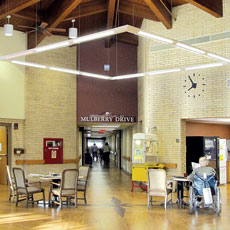
A recipe for a complicated nursing home renovation: Take one facility that hasn’t been updated in 45 years, add a strict budget and keep residents on site throughout the project.
Columbia Health Care Center in Wyocena, WI, recently completed exactly this type of complex renovation. The 124-bed facility, located about 30 miles north of Madison, had not been significantly renovated since opening in 1966. The facility needed upgrades for compliance and to enhance quality of life elements, such as adding more dining areas and private bathrooms.
The county provided $3.7 million for renovations in 2009. The nursing home would lose any money not spent, so administrator Amy Yamriska wanted to accomplish all core priorities while carefully selecting discretionary projects.
The facility found an able partner in Hoffman Planning, Design & Construction Inc. Hoffman planned for the non-negotiable elements and then created a menu of add-ons. For example, replacing the decaying roof was on the must-do list, but replacing ceiling tiles was a bonus.
“They had a wonderful bid review process,” Yamriska says of Hoffman. “Selecting bids that gave us the most for our money allowed us to stretch our budget for additional projects to enhance our residents’ lives.”
Hoffman was also thrifty in limiting temporary structures. Instead of temporary covered walkways, the builders created sturdier structures that converted to permanent covered porches at the end of construction. And Hoffman budgeted for unforeseen expenses, knowing some of the aged building’s infrastructure would have to be replaced. Sure enough, after decades of not being turned on or off, all the building’s plumbing valves had to be changed.
“You’re trying to reuse as much existing equipment as possible, but you’re going to end up replacing more equipment than you had hoped,” says Bill Aubrey, senior project manager and architect.
The renovation also had to be done without relocating residents. This meant residents with private rooms took on roommates.
“Before we started the renovation, we sent letters out to everybody, put it in the newsletter with estimated timeframes,” Yamriska says. The staff created a large board with information, had monthly meetings and paired roommates carefully.
The residents had a great attitude throughout the project, Yamriska says. Hoffman played a key role in keeping them healthy and happy.
“We sat down [contractors] and explained how important it was not to impact the owners’ operations,” says project manager Tom Hoffman. This meant no jackhammers, building thick partitions to mask sound, and doing power changeovers and water shutdowns between 2 a.m. and 5 a.m.
The construction company also worked on one wing at a time to minimize disruptions. Work was completed in December 2012.
Like many complex recipes, this one had a great payoff for the palate. Yamriska says one of the things that residents are most impressed with is the new, quieter dining areas closer to their rooms.
Lessons learned
Plan to replace rather than retrofit existing equipment in an older building.
To stretch the budget, look for ways to limit temporary structures during construction.
Communication with residents and families is critical during a renovation.
From the May 01, 2013 Issue of McKnight's Long-Term Care News




